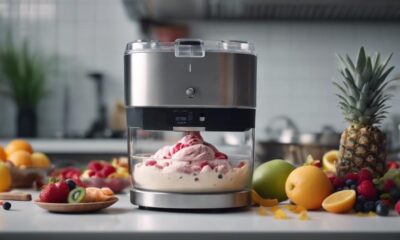Frozen Delights
How to Tell if Ice Cream Has Melted and Refrozen: Stay Safe!
Open the lid to unravel the mystery of melted and refrozen ice cream – discover the telltale signs for a safe indulgence!
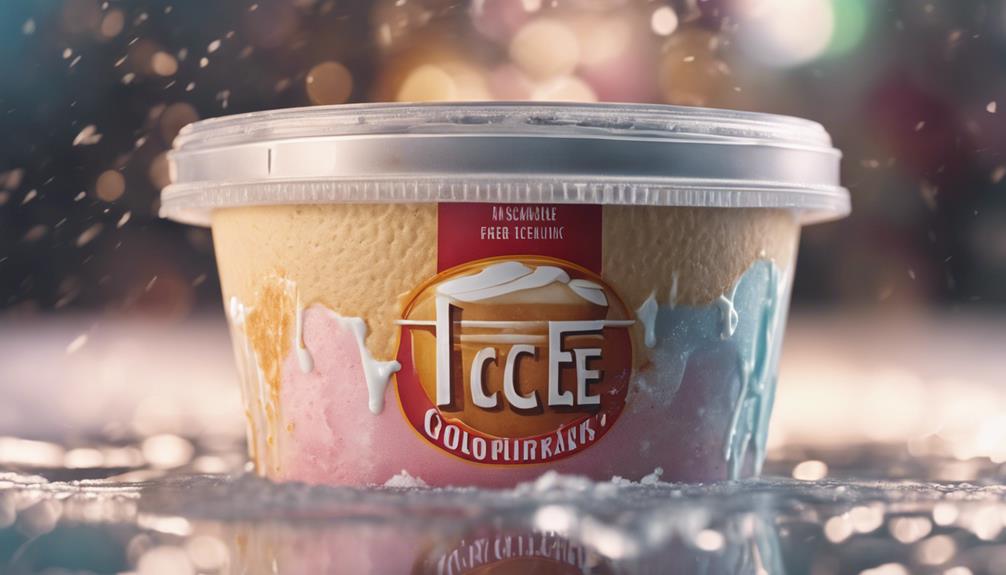
If your ice cream feels gritty or has sticky containers, it might have melted and refrozen, affecting its safety. Look for changes in texture, larger ice crystals, and different taste. Melting and refreezing can result in bacterial growth, which could lead to food poisoning. It is crucial to handle and store ice cream correctly at 0°F to prevent health hazards. Be alert for a runny consistency or ice crystals as indicators of spoilage. Be aware of symptoms such as fever or diarrhea as signs of food poisoning. Being familiar with these signs will allow you to savor ice cream safely.
Key Takeaways
- Grainy texture and changed consistency indicate melted and refrozen ice cream.
- Loss of air pockets causes graininess in refrozen ice cream.
- Sticky or frosty containers signal melted and refrozen ice cream.
- Larger ice crystals and altered consistency from refreezing are signs.
- Refrozen ice cream may not fit snugly in the carton after melting.
Signs of Melted Ice Cream

If you suspect your ice cream has melted, look for a grainy texture and changes in consistency. When ice cream melts and is refrozen, the loss of air pockets during the melting process causes the texture to become grainy. Refreezing results in the formation of larger ice crystals, leading to alterations in the ice cream's consistency.
Keep an eye out for containers that appear sticky or frosty, as these are signs that the ice cream has melted and refrozen. Additionally, refrozen ice cream may not fit snugly in the carton after it has undergone this process.
It is important to recognize these indicators as refrozen ice cream tends to be less creamy and more crystallized, affecting its overall quality. Additionally, the changes in texture provide a breeding ground for bacteria to grow, potentially posing health risks.
Bacterial Growth on Ice Cream
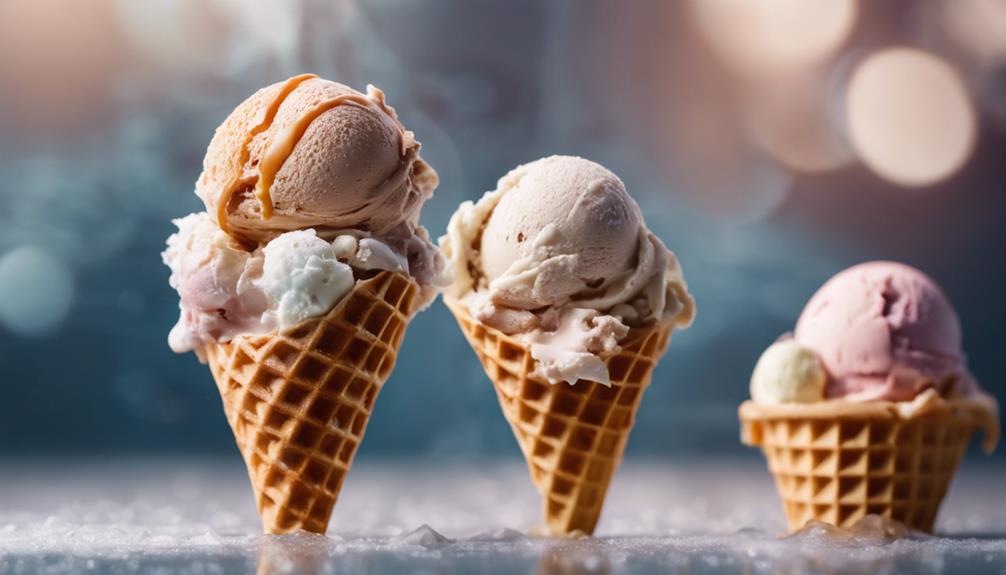
Watch out for bacterial growth on ice cream, especially if it has melted and refrozen, as specific temperatures and conditions can promote the multiplication of harmful bacteria like Listeria and Salmonella.
When ice cream melts, it enters the temperature danger zone of 40°F to 140°F, providing an ideal environment for bacteria to thrive and potentially contaminate the dessert. Bacteria, such as Listeria and Salmonella, can cause food poisoning if the melted ice cream is consumed after being refrozen.
Milk or cream-based ice creams are particularly susceptible to bacterial growth, as these dairy products offer a rich nutrient source for bacteria to multiply.
It's important to note that freezing melted ice cream doesn't eliminate any toxins produced by bacteria during the period it was in the temperature danger zone.
Hence, to make sure the ice cream is safe to eat and free from harmful bacteria, it's important to handle it properly and avoid leaving it out at room temperature for extended periods.
Refreezing Non-Dairy Ice Cream

When refreezing non-dairy ice cream, be mindful of potential ingredient separation due to differences in freezing points between plant-based alternatives like coconut milk or almond milk.
Unlike dairy ice cream, non-dairy options can have a different texture and taste after being melted and refrozen. Although refreezing non-dairy ice cream may not pose as high a risk to your health compared to dairy ice cream, there are still factors to keep in mind. The added ingredients in non-dairy ice cream can impact its quality when refrozen, potentially affecting its overall taste and consistency.
If you're contemplating whether to refreeze non-dairy ice cream that has melted, take into account the potential changes that may occur. While it's generally safer than refreezing dairy ice cream, be mindful that the texture and flavor might be altered.
Keep an eye out for any signs of ingredient separation or unusual changes in the ice cream's appearance, as these could indicate that it's best not to refreeze it. By taking these factors into consideration, you can enjoy your non-dairy ice cream without putting your health at risk.
Proper Ice Cream Storage
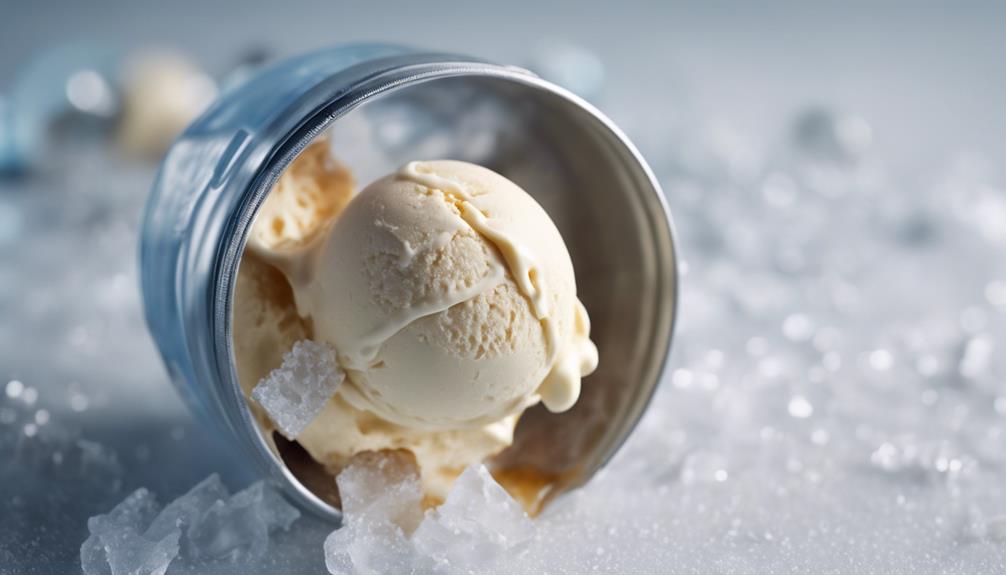
You should always store your ice cream in the freezer at 0°F to preserve its quality and prevent bacterial growth.
Keeping an eye out for any signs of melting, like a soupy texture or ice crystals, is essential to guarantee your ice cream hasn't gone bad. Additionally, checking for any unusual odors or off-flavors can also indicate that your ice cream has spoiled. It’s important to note that plastic found in ice cream can also be a sign that the product has gone bad, so be sure to inspect your ice cream carefully before consuming it. If you have any doubts about the quality of your ice cream, it’s best to err on the side of caution and throw it out to avoid any potential foodborne illnesses.
Storage Temperature Importance
Maintaining ice cream at temperatures below 0°F (-18°C) is essential for preserving its quality and texture.
Here are three key points emphasizing the importance of storage temperature:
- Prevents melting and refreezing: Storing ice cream at sub-zero temperatures helps avoid the risk of it melting and refreezing, which can lead to unwanted texture changes.
- Avoids large ice crystals: Proper storage temperature prevents the formation of large ice crystals in ice cream when it melts and refreezes, ensuring a smooth and creamy consistency.
- Maintains taste integrity: By keeping ice cream consistently frozen at the correct temperature, you can preserve its original taste profile and prevent any alterations caused by temperature fluctuations.
Preventing Bacterial Growth
Proper ice cream storage is necessary for preventing bacterial growth and ensuring the safety of consumption. Bacteria such as listeria can thrive in food that has been improperly stored, potentially putting your health at risk.
When ice cream melts and refreezes, the ice crystals that form can cause the cells to break and lose their structure, creating an environment where bacteria can multiply. To prevent this, it's vital to store commercially manufactured ice cream at recommended temperatures to inhibit bacterial growth.
Homemade ice cream should be stored in airtight containers in the freezer to avoid contamination. Additionally, storing ice cream separately from raw ingredients in the freezer can help minimize bacterial growth.
Regularly checking the freezer temperature and cleanliness is also important in maintaining the quality and safety of your ice cream. By following these storage practices, you can enjoy your favorite frozen treat without worrying about bacterial contamination.
Causes of Ice Cream Food Poisoning

You may be wondering about the causes of ice cream food poisoning.
Bacterial risks in ice cream arise from contamination sources during manufacturing or at home.
Understanding the symptoms of food poisoning can help you identify any issues with your ice cream.
Bacterial Risks in Ice Cream
Ice cream can pose a risk of food poisoning due to bacterial contamination, potentially leading to illnesses such as Listeria and Salmonella infections. When ice cream that has melted is left at room temperature or refrozen, it creates an environment where bacteria can thrive.
Here are some key points to take into account regarding bacterial risks in ice cream:
- Melted ice cream at room temperature: When ice cream melts and is left out at room temperature, it provides an ideal breeding ground for bacteria like Listeria, increasing the risk of contamination.
- Contamination sources: Bacterial contamination can occur during various stages such as manufacturing, shipment, or even during homemade ice cream preparation, highlighting the importance of ensuring proper hygiene practices.
- Egg products in ice cream: Ice creams that contain egg products can also pose a risk, as eggs, if not pasteurized, can harbor Salmonella bacteria, potentially leading to infections if consumed. Commercially manufactured ice cream with egg products should be handled and stored carefully to prevent bacterial growth.
Contamination Sources
Manufacturing processes, shipment handling, and homemade preparation all play a significant role in contamination sources contributing to ice cream-related food poisoning risks.
When ice cream is melted and refrozen, it creates an ideal environment for bacterial growth, particularly Listeria. During manufacturing, if proper sanitation practices aren't followed, bacteria like Salmonella and E. coli can contaminate the ice cream.
Additionally, mishandling during shipment can lead to temperature abuse, causing the ice cream to melt and refreeze, increasing the risk of bacterial contamination.
In homemade ice cream, unpasteurized ingredients such as eggs can harbor Salmonella, while the milk or cream base may contain harmful bacteria like Listeria and E. coli if not pasteurized correctly.
Whether it's store-bought or homemade, ensuring proper handling and storage of ice cream is essential to prevent bacterial contamination and reduce the risk of food poisoning.
Symptoms of Food Poisoning
Symptoms of food poisoning from consuming ice cream may typically manifest as fever, diarrhea, and abdominal cramps within a timeframe of 12 to 72 hours post-consumption. If you suspect that ice cream has melted and refrozen, it's essential to be aware of the potential symptoms of food poisoning to seek timely medical attention.
Here are some key points to keep in mind:
- Fever: A persistent high body temperature is a common indicator of food poisoning caused by contaminated ice cream.
- Diarrhea: Frequent loose or watery stools can be a sign of gastrointestinal distress resulting from consuming compromised ice cream.
- Abdominal Cramps: Intense stomach pains or discomfort may accompany other symptoms and indicate food poisoning from improperly handled or stored ice cream.
Recognizing these symptoms promptly after consuming suspect ice cream can help in addressing any potential food poisoning concerns and seeking appropriate medical care.
Risks of Mishandling Ice Cream
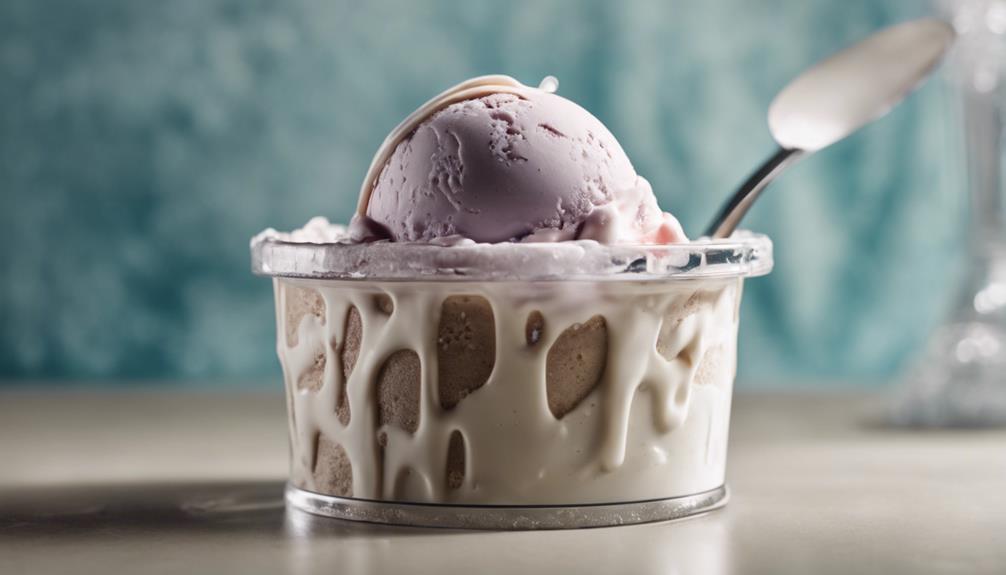
Improper handling of ice cream can greatly impact its taste and texture. When ice cream is melted and refrozen multiple times, it undergoes changes that affect its overall quality. Some common mishandling practices include using microwaves to soften ice cream quickly or leaving it out at room temperature for extended periods. This can lead to a loss of the creamy, whipped consistency that makes ice cream so enjoyable.
To highlight the risks of mishandling ice cream, let's take a look at the potential consequences:
| Risk | Impact | Prevention |
|---|---|---|
| Ice cream melts and refreezes | Loss of creamy texture and flavor | Store ice cream in a freezer at proper temperature |
| Using microwaves to soften ice cream | Alters texture and taste negatively | Thaw ice cream in the refrigerator for gradual softening |
| Leaving ice cream out too long | Increases the risk of bacterial growth | Follow recommended storage guidelines |
Proper storage and handling of ice cream are essential to maintain its delicious taste and creamy consistency. Avoid mishandling practices to enjoy your ice cream to the fullest.
Frequently Asked Questions
Is It Okay to Eat Ice Cream After It's Melted and Refrozen?
Eating ice cream after it's melted and refrozen isn't recommended. It can lead to texture changes, larger ice crystals, and increased risk of bacterial growth. For safety, it's best to discard melted ice cream.
How Long Can Ice Cream Sit Out and Be Refrozen?
You should never leave ice cream out for more than 2 hours before putting it back in the freezer. Bacteria love temperatures between 40°F to 140°F, so keep that delicious treat safe by chilling it promptly.
Does Ice Cream Go Bad if It Thaws?
If ice cream thaws, it can go bad if left out too long, leading to bacterial growth. Refreezing it may change the texture and taste, affecting your enjoyment. To stay safe, handle melted ice cream carefully.
Does Refrozen Ice Cream Taste Different?
When you refreeze ice cream, it can taste different due to altered texture and larger ice crystals. Loss of air pockets affects creaminess, making it dense and less smooth. Remember to take into account the impact on taste and texture.
Conclusion
So, remember to always check for signs of melted ice cream before digging in. Nobody wants to risk getting sick from bacterial growth or refrozen ice cream.
Make sure to store your ice cream properly to avoid any mishaps.
Stay safe and enjoy your frozen treats without any worries – better safe than sorry, right?
Mario’s creativity shines through his ability to describe the sensory experience of enjoying ice cream. Whether he’s discussing the velvety texture, the explosion of flavors, or the delightful combinations of toppings and sauces, his words transport readers to a world of mouthwatering sensations. His descriptive language allows readers to imagine and savor the flavors even before taking the first bite.
Frozen Delights
The Role of Air in Ice Cream: Understanding Overrun
You won’t believe how air affects your ice cream’s texture and flavor; discover the secrets of overrun and elevate your creations!
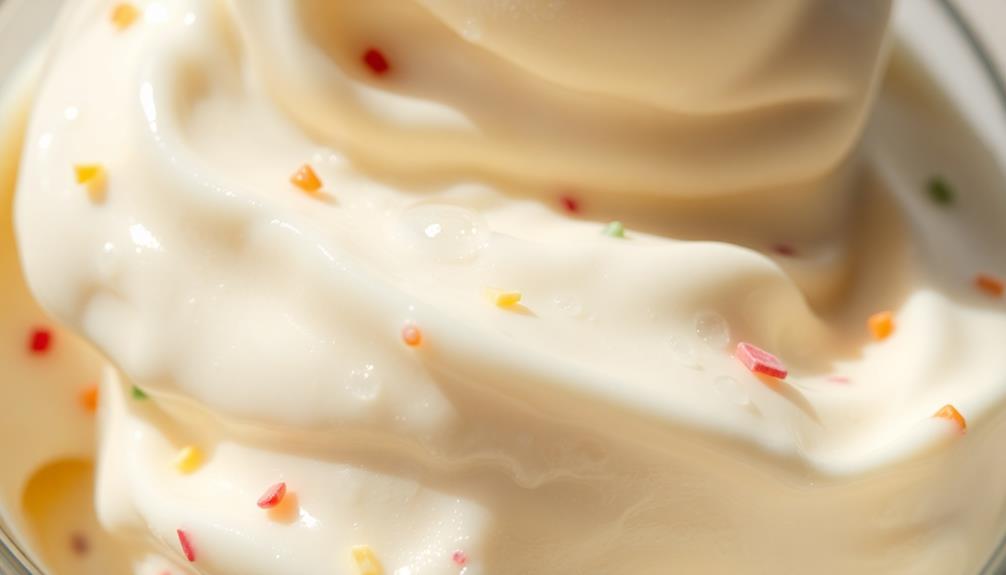
Air is essential in ice cream, as it influences texture and flavor through a process called overrun. Overrun measures the air content, impacting how light or dense your ice cream feels. A typical overrun ranges from 20% to 50%, with higher amounts creating a fluffier texture. Too little air results in dense ice cream, while too much can dilute flavor. Consistency in overrun guarantees quality and satisfies customers. Using advanced machines can help maintain the ideal overrun level, enhancing your product's appeal. Stick around to discover how air dynamics can transform your ice cream-making experience.
Key Takeaways
- Overrun measures the percentage of air in ice cream, significantly affecting its texture, volume, and overall quality.
- Higher overrun levels create a lighter, fluffier texture, while lower levels result in denser, heavier ice cream.
- Consistent overrun is crucial for maintaining flavor and mouthfeel, impacting customer satisfaction and brand loyalty.
- Emulsifiers stabilize air bubbles, enhancing the creamy texture and preventing separation in ice cream products.
- Innovations like zero overrun technology allow for unique textures and concentrated flavors, transforming traditional ice cream experiences.
Definition of Overrun
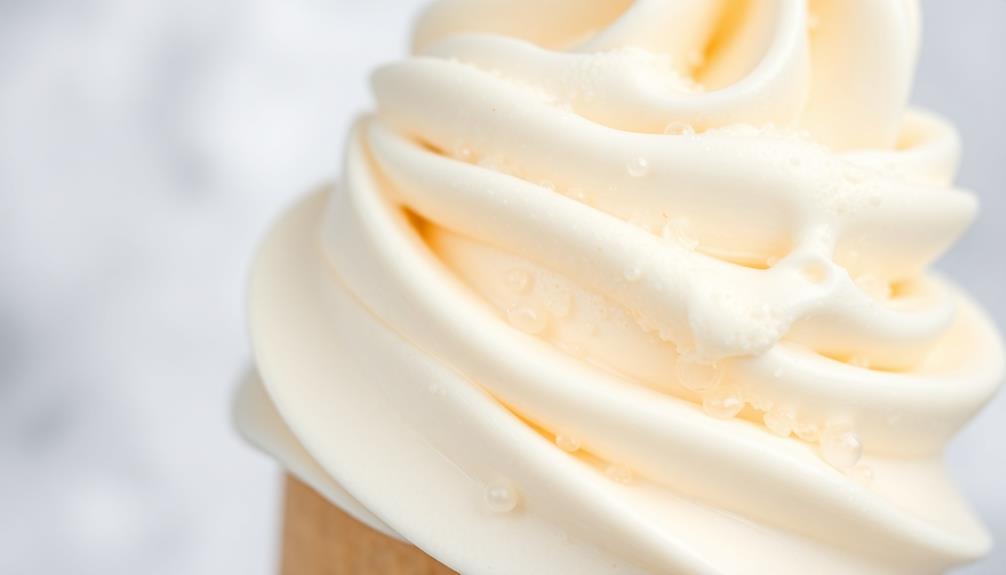
Overrun refers to the percentage of air incorporated into ice cream during the freezing process, and it plays an essential role in determining both the texture and volume of the final product. When you calculate overrun, you're looking at how much air is added. For instance, if 1 gallon of ice cream mix produces 1.3 gallons of ice cream, that results in a 30% overrun.
Different machines yield varying levels of overrun. Gravity-fed machines typically achieve 25%-35%, while pressurized machines can exceed 65%. For premium soft serve ice cream, the recommended overrun is between 50%-60%, which contributes to a smooth and fluffy texture that many enjoy.
The quality of your ice cream is directly influenced by how well your equipment can maintain consistent overrun levels. High-quality machines are essential for achieving the ideal air-to-ice cream ratio, ensuring that the end product is both appealing and functional.
Understanding overrun helps you appreciate the delicate balance of air and ingredients that gives ice cream its delightful texture and volume.
Effects of Overrun Levels

The texture and taste of ice cream can considerably change based on the level of overrun. High overrun, typically exceeding 60%, creates a fluffy texture that can dilute flavor, negatively impacting your experience. On the other hand, low overrun, below 30%, results in a dense and heavy ice cream that might not satisfy your craving for a light, creamy texture.
The ideal overrun for premium soft serve ice cream sits between 30% and 60%, striking a balance that enhances both volume and texture, guaranteeing customer satisfaction. Here's a quick look at how different overrun levels affect your ice cream experience:
| Overrun Level | Texture | Customer Experience |
|---|---|---|
| Low (<30%) | Dense | May feel heavy |
| Moderate (30-60%) | Creamy | Balanced satisfaction |
| High (>60%) | Fluffy | Flavor dilution |
Managing overrun correctly is crucial for maximizing product volume and profitability. When you understand these effects, you can better appreciate the science behind your favorite treat and guarantee a delightful experience every time.
Importance of Consistency

Achieving a consistent overrun is key to delivering high-quality soft serve ice cream. When you master overrun levels, you guarantee a uniform texture that meets customer expectations.
Variability in overrun can lead to noticeable differences in taste and mouthfeel, which can negatively impact customer satisfaction. Regular monitoring of overrun helps you maintain that crucial consistency, assuring your product reliably meets the desired texture and flavor profiles.
Inconsistent overrun can result in a poor customer experience; products that are too fluffy or overly dense can drive customers away. By focusing on maintaining consistency in your overrun, you not only enhance the enjoyment of your ice cream but also support your brand reputation in the market.
Consumers are more likely to favor brands that offer reliable quality, and that's where consistency plays an essential role.
Ultimately, paying attention to your overrun levels isn't just about creating a great product; it's about building loyalty with your customers. High-quality ice cream that consistently delivers on taste and texture keeps customers coming back for more, bolstering your brand's reputation and success in a competitive industry.
Stoelting's Innovative Solution
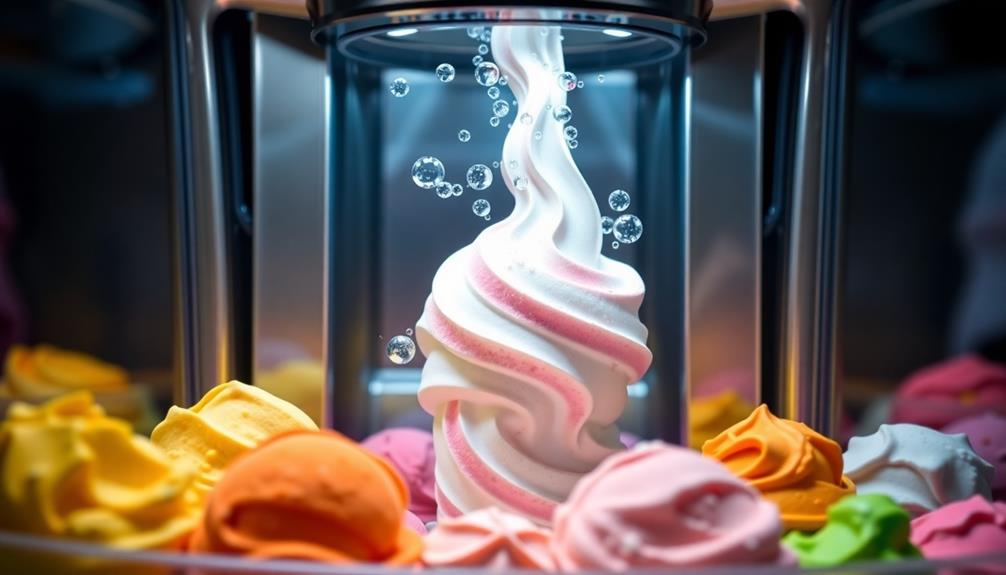
Stoelting's innovative solutions revolutionize soft serve production by integrating automatic overrun settings that give you precise control over air incorporation. With their advanced soft serve machines, you can achieve consistent, high-quality overrun, which is essential for creating the perfect texture and flavor in your products.
The unique carburetor design in Stoelting machines guarantees that air is incorporated efficiently, allowing you to tailor the overrun levels to meet specific consumer preferences. By adjusting the settings, you can customize the texture of your soft serve, enhancing the overall experience for your customers.
This flexibility not only elevates your product but also helps you stand out in a competitive market. Stoelting prioritizes user-friendly operation, which reduces the risk of operator error and enhances the reliability of overrun management, even in high-volume production settings.
Ultimately, by improving overrun consistency and quality, Stoelting machines contribute greatly to your profitability. You'll find that the ability to control air incorporation leads to better product outcomes, assuring your soft serve offerings meet the high standards your customers expect.
With Stoelting, you're not just making ice cream; you're crafting an experience.
Benefits of Using Stoelting Machines
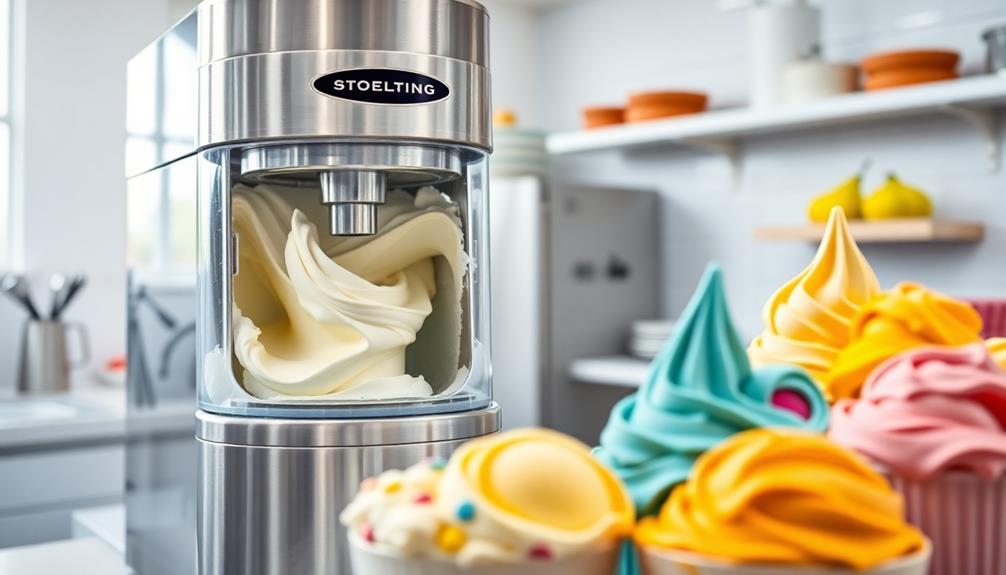
When it comes to making exceptional soft serve, many operators find that using Stoelting machines can transform their production process.
These machines feature automatic overrun settings, giving you precise control over air incorporation. This control is vital for achieving the consistent quality your customers expect.
With the unique carburetor design, Stoelting machines guarantee stable overrun, minimizing variability in texture and flavor across batches.
The adjustable settings allow you to customize the product texture, catering to diverse consumer preferences while maintaining high standards.
You won't have to worry about operator error, either, as the user-friendly operation reduces the chances of mistakes, promoting efficiency in your soft serve production.
Role and Importance of Air
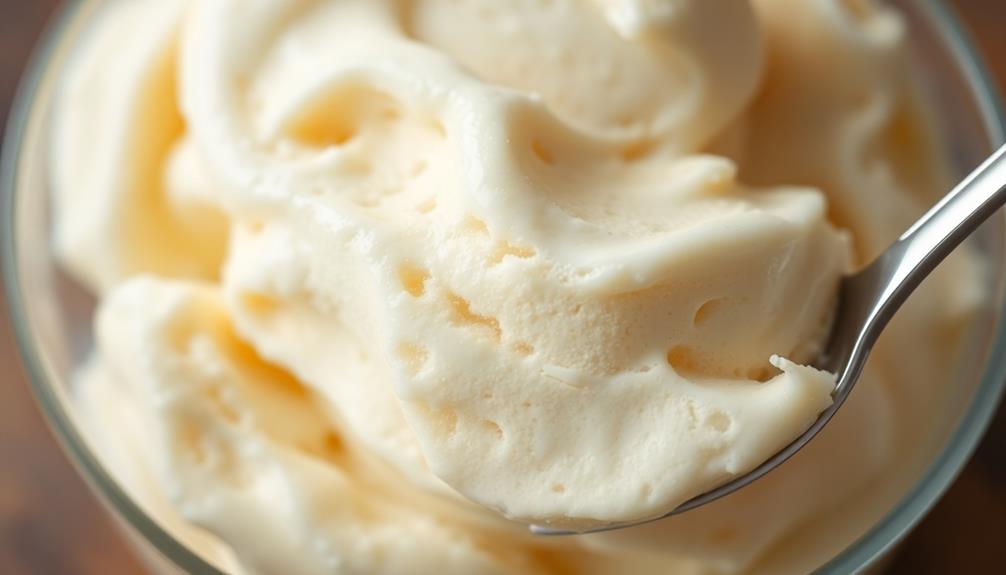
Air plays an essential role in the texture and quality of ice cream, impacting everything from softness to mouthfeel. When you churn ice cream, air is incorporated, and this process is measured as overrun. The typical overrun ranges from 20% to 50%, which greatly influences the final product's texture. Higher air content creates a lighter and fluffier ice cream, enhancing the overall experience.
The air bubbles formed during churning also stabilize the structure of the ice cream. Smaller bubbles are key to achieving that desirable creaminess, while larger bubbles can result in a grainy texture that detracts from enjoyment.
For the bubbles to effectively hold their shape, a proper balance of butterfat and protein is essential. Milk proteins cling to the surfaces of air bubbles, preventing them from merging, which is fundamental for stabilization.
Incorporation and Measurement of Air
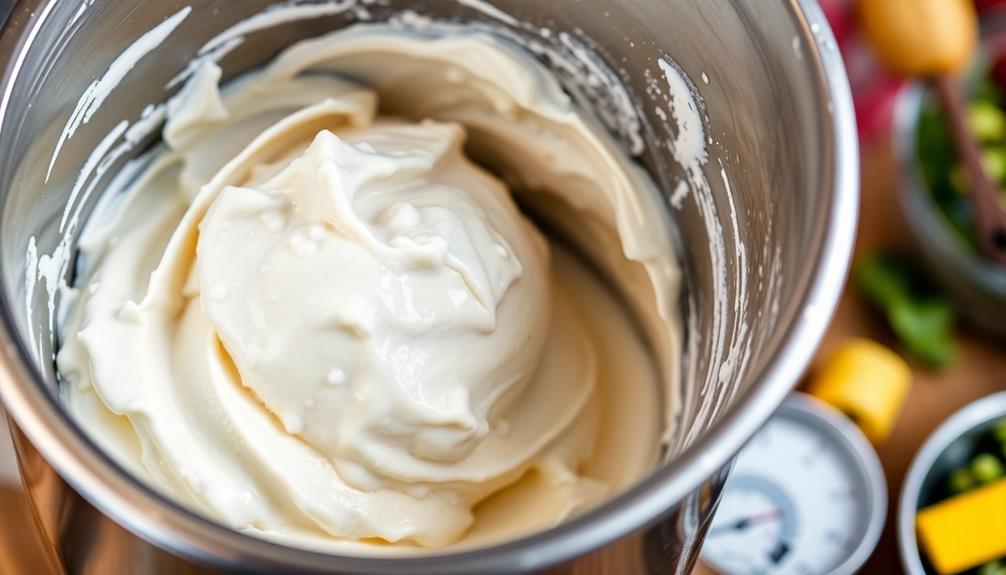
While the process of churning ice cream may seem straightforward, the incorporation and measurement of air are vital for achieving the desired texture and quality.
Understanding how air is incorporated can help you create smoother, creamier ice cream. Here's what you need to know:
- Dasher Speeds: Higher dasher speeds introduce more air bubbles in ice cream, enhancing volume and texture.
- Frozen Mix Viscosity: The thickness of your mix affects how much air can be incorporated; a thicker mix may trap fewer air bubbles.
- Churning Duration: Longer churning times typically result in higher overrun, meaning more air incorporated, which can lead to a lighter product.
- Overrun Means: Overrun is the measurement of air added; for instance, if a 1-quart frozen mix expands to 1.5 quarts, that's a 50% overrun.
These factors influence the final product's creaminess, so it's important to pay attention to how you integrate and measure air.
Proper air incorporation not only enhances texture but also prevents larger bubbles, ensuring you achieve that perfect creamy ice cream.
Stabilization of Air Bubbles
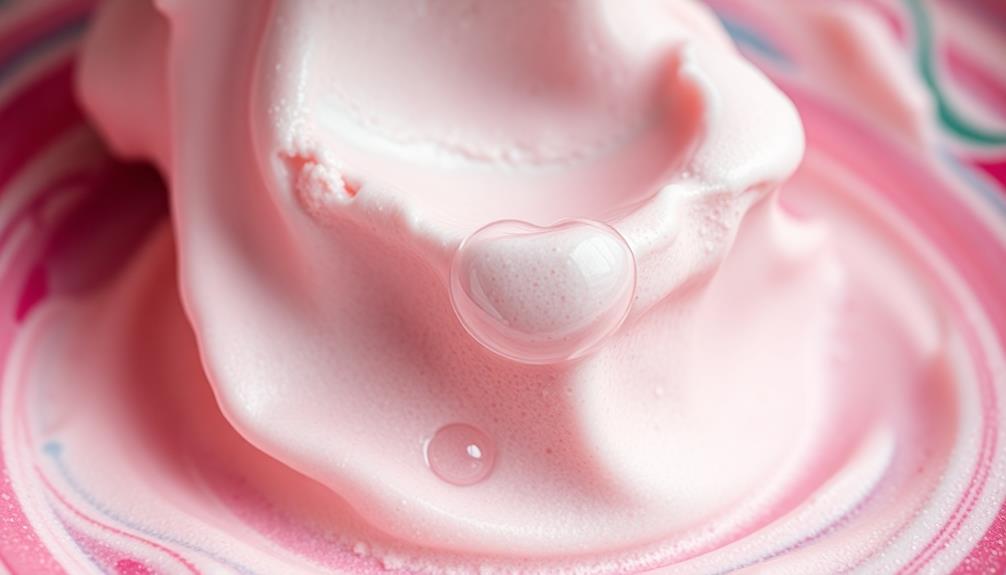
When you make ice cream, the size and stability of air bubbles are essential for achieving that creamy texture you love.
Emulsifiers play a key role in this process by helping to stabilize the bubbles and prevent them from merging.
Understanding how these factors interact can help you create a smoother, more enjoyable ice cream experience.
Air Bubble Size Dynamics
The stabilization of air bubbles plays an essential role in the texture and quality of ice cream. During the churning process, air bubbles in ice cream start off larger, but the shear stress from dynamic freezing reduces their size, creating smaller bubbles that enhance creaminess.
The average bubble size can increase from about 23 µm after churning to 43 µm during hardening, affecting the final properties of ice cream.
Key factors influencing air bubble size dynamics include:
- Rotor Speed: Higher speeds lead to smaller bubbles, optimizing overrun.
- Viscosity of the Mix: Thicker mixtures can help stabilize smaller bubbles.
- Residence Time: Longer churning times allow for more uniform bubble sizes.
- Stabilizers: Proteins and surfactants create a protective layer, preventing coalescence of the fat.
Proper air bubble stabilization is vital, as it directly impacts the texture and mouthfeel of ice cream. Smaller, stable air cells contribute to a smoother, creamier experience.
Role of Emulsifiers
Emulsifiers work wonders in stabilizing air bubbles in ice cream, playing a fundamental role in achieving that luscious, creamy texture you love. These ingredients, like mono- and diglycerides, reduce the surface tension around air bubbles, facilitating their stabilization. By enhancing fat destabilization, emulsifiers help create smaller air bubbles, essential for that smooth mouthfeel you crave.
Moreover, emulsifiers guarantee uniform fat distribution, preventing separation and greatly improving foam stability. This stabilization is imperative for maintaining the desired overrun levels, which directly influences ice cream quality. When the balance is just right, you get a delightful consistency; however, excess emulsifiers can lead to undesirable butter particle formation, negatively affecting sensory attributes.
The interaction between emulsifiers and air bubbles is critical during the freezing process, as it guarantees that the air bubbles remain stable. This stability not only contributes to the texture but also enhances the overall quality of the final product.
Innovations and Future Trends

As you explore the future of ice cream, you'll notice a push towards zero overrun technology, which promises richer flavors and creamier textures.
Plus, the rise of alcohol-infused ice cream is creating exciting new options for those looking for a twist on traditional treats.
These innovations reflect changing consumer preferences and a desire for higher quality in every scoop.
Zero Overrun Technology
If you've ever wished for a denser, creamier ice cream experience, zero overrun technology might just be the answer. This innovative approach eliminates air incorporation, resulting in a product that's not only dense and creamy but also rich in flavor.
Here are some key benefits of zero overrun technology:
- Minimized Air Bubbles: By reducing air bubbles, the texture of the ice cream becomes smoother and more indulgent.
- Maximized Flavor Intensity: The absence of air allows for a more concentrated flavor profile, making each bite more satisfying.
- Exploration of New Textures: Manufacturers can experiment with unique textures that traditional ice cream production can't achieve.
- Potential Regulation Changes: As this technology evolves, it may influence industry standards, encouraging transparency in labeling practices regarding air content.
With zero overrun technology, you're not just enjoying ice cream; you're experiencing a new level of indulgence.
Imagine savoring flavors that burst in your mouth, thanks to the advancements in ice cream production. The future of ice cream is here, and it's creamier, denser, and more flavorful than ever!
Alcohol-Infused Ice Cream
Alcohol-infused ice cream is revolutionizing the dessert landscape, blending the creamy indulgence of ice cream with the spirited flavors of cocktails. This innovative treat can achieve up to 20% alcohol by volume (ABV), resulting in unique flavor combinations and textures that excite the palate.
However, incorporating alcohol into ice cream presents challenges. You'll need to find the right balance between flavor and texture since higher alcohol levels can affect freezing points and stability.
To tackle this, a new patented process is in development that allows for the freezing of high-proof alcohol into hard scoop ice cream. This breakthrough could expand your gourmet dessert options considerably.
As you explore these alcohol-infused delights, you'll notice the importance of air; it helps create a smooth texture that enhances the overall experience.
These desserts often target niche markets, appealing to those seeking premium, indulgent experiences that marry ice cream with cocktail culture.
As regulatory changes promote transparent labeling practices, you'll find it easier to understand the ingredients and ABV levels in these delightful mixtures.
The future of alcohol-infused ice cream is bright, combining creativity with culinary science for an exciting dessert experience.
Frequently Asked Questions
What Is the Function of Air in Ice Cream?
Air's function in ice cream's churning process is essential. It creates a soft, pleasant texture, preventing the mix from freezing solid. You'll enjoy a lighter, fluffier experience, enhancing the overall taste and mouthfeel.
What Causes Overrun in Ice Cream?
Did you know that commercial ice cream can have over 100% overrun? Overrun in ice cream happens when air gets whipped into the mix during churning, affecting texture and volume while enhancing your enjoyment.
How Does Air Impact the Melting Rate of Ice Cream?
Air impacts the melting rate of ice cream by creating larger pockets within the mixture. When you take a bite, that fluffiness means it warms up quickly, causing it to melt faster than denser varieties.
What Does Too Much Air in Ice Cream Mix Cause?
Ever wonder why your ice cream doesn't taste as rich? Too much air in the mix can lead to a fluffy texture, dilute flavors, and create a grainy mouthfeel, ruining your creamy experience. Enjoy it right!
Conclusion
In summary, understanding the role of air in ice cream and overrun is essential for creating that perfect creamy texture. As you explore Stoelting's innovative solutions, consider how they help maintain consistency while incorporating air effectively. Isn't it fascinating how the right balance of air can transform a simple treat into a luxurious experience? By embracing these advancements, you can elevate your ice cream-making game and delight your customers with every scoop.
Beyond the realm of flavor and technique, Adriano recognizes the importance of sustainability and conscious consumption. His writing often explores eco-friendly practices within the ice cream industry, highlighting the use of locally sourced ingredients, reducing waste, and supporting ethical production methods.
Frozen Delights
How Stabilizers Work in Ice Cream Production
Navigating the world of ice cream production reveals how stabilizers create that perfect creamy texture—discover the secrets behind their essential roles.

Stabilizers are essential in ice cream production because they enhance texture and guarantee a creamy mouthfeel. They work by increasing the mix's viscosity and preventing large ice crystals from forming during freezing. This keeps your ice cream smooth and enjoyable. You'll find various stabilizers like guar gum and xanthan gum, each with unique benefits like moisture retention and improved structure. They also help manage air bubbles for peak creaminess. By controlling these elements, stabilizers guarantee a delightful experience with every scoop. If you're curious about the types of stabilizers and their specific roles, you'll find more insights just ahead.
Key Takeaways
- Stabilizers enhance ice cream texture by increasing viscosity, resulting in a smoother mouthfeel and preventing larger ice crystals from forming.
- They create gel-like structures that limit ice crystal growth and minimize recrystallization, preserving texture and flavor over time.
- Stabilizers improve air bubble control, allowing for lighter textures and preventing air bubble merging during storage.
- They help maintain a stable microstructure during temperature fluctuations, ensuring consistent quality and creaminess throughout the product's shelf life.
- Recommended concentrations for stabilizers range from 0.2% to 0.5% of the total mix weight for optimal performance in ice cream production.
Role of Stabilizers in Ice Cream
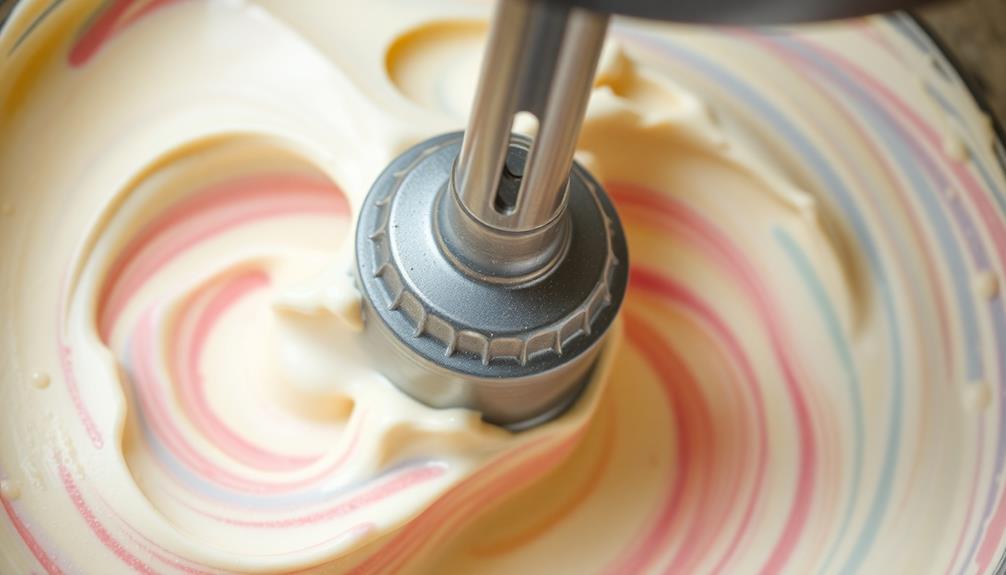
Stabilizers play an essential role in enhancing the texture and overall quality of ice cream. When you add stabilizers like guar gum and locust bean gum, you increase the viscosity of the ice cream mix. This improved viscosity is vital for creating a smoother mouthfeel, as it prevents the formation of larger ice crystals during freezing.
By maintaining smaller ice crystal sizes—ranging from 10 to 20 µm—you achieve that desirable creamy texture that makes ice cream so enjoyable.
Additionally, stabilizers effectively limit ice recrystallization, which can occur over time. This means they help maintain the integrity of the flavor and texture even after the ice cream has been stored for a while, effectively extending its shelf life.
It's important to use stabilizers at the right concentration, typically between 0.2% and 0.5% of the total mix weight. If overused, however, they can lead to undesirable textures, such as gumminess.
In ice cream production, choosing the right stabilizers is key to ensuring that every scoop remains delightfully smooth and satisfying.
Types of Stabilizers Used
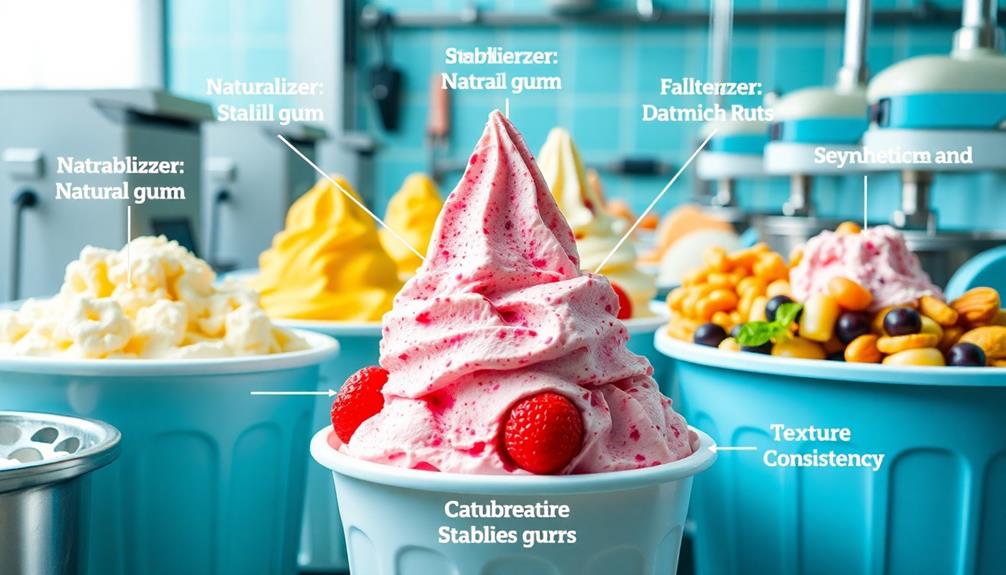
In ice cream production, various types of stabilizers contribute to achieving the desired texture and stability of the final product. Here are some common stabilizers you'll encounter:
- Guar Gum (E412): Enhances viscosity and texture, making ice cream smoother.
- Locust Bean Gum (E410): Often paired with other stabilizers for improved functionality and better texture.
- Xanthan Gum (E415): Known for its excellent thickening properties, it helps stabilize emulsions, ensuring that your ice cream stays creamy.
- Carrageenan (E407): Prevents whey separation and notably improves overall texture, keeping your ice cream consistent.
Additionally, pectin (E440) retains moisture and adds a smooth mouthfeel, especially in fruit-flavored varieties.
While gelatin (E441) was once a go-to stabilizer, plant-based polysaccharides are now favored in many vegan formulations.
Each stabilizer has unique characteristics that influence your choice based on the desired texture and stability of your ice cream.
Mechanisms of Stabilization
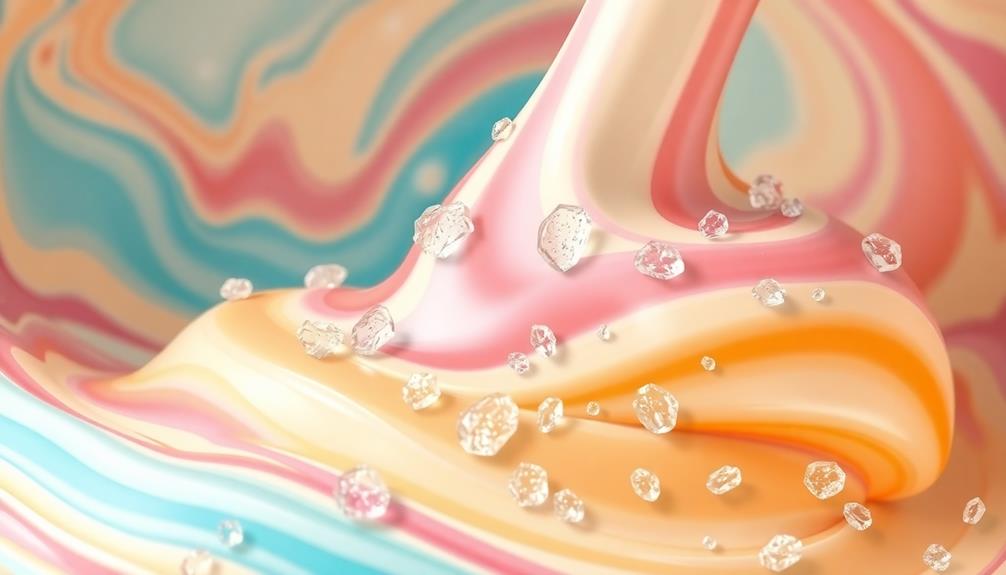
When you add stabilizers to ice cream, they play an essential role in managing ice crystals and controlling air bubbles.
By forming a gel-like structure, they help keep ice crystals small and prevent them from growing during freezing.
This not only guarantees a smooth texture but also maintains the creaminess you love in every scoop.
Ice Crystal Management
To achieve the smooth texture that makes ice cream so enjoyable, effective ice crystal management is vital. Stabilizers play a significant role in this process by helping maintain smaller ice crystal sizes during the freezing process. Larger ice crystals can lead to a gritty mouthfeel, so here's how stabilizers enhance the ice cream experience:
- Gel-like Structures: Stabilizers form gel-like structures that limit the movement of water molecules, reducing ice crystal growth.
- Altered Freezing Point: They modify the freezing point of the ice cream mix, allowing for smoother textures at lower temperatures.
- Reduced Free Water: By interacting with water, stabilizers minimize free water content, which enhances creaminess and decreases ice crystal formation.
- Temperature Stability: Stabilizers help maintain a stable microstructure during storage, mitigating the effects of temperature fluctuations that can exacerbate ice crystal growth.
With these mechanisms in place, stabilizers guarantee a consistent smoothness and overall quality, making each scoop a delightful experience.
Air Bubble Control
Air bubble control is fundamental for achieving that light and creamy texture in ice cream, and stabilizers play a key role in this process. By increasing the viscosity of the ice cream mix, stabilizers create smaller air bubbles and thicken the films around them. This prevents the air bubbles from merging during storage, maintaining the desired creaminess in your final product.
Stabilizers also enhance aeration by trapping air within a gel-like network, which results in a lighter texture. Proper use of stabilizers slows down the movement of air bubbles, reducing the risk of foam collapse. This is essential for maintaining the structure of your ice cream during serving.
Moreover, stabilizers interact with water molecules, limiting their mobility. This minimizes the potential for air bubble coalescence, ensuring your ice cream remains light and airy.
Additionally, stabilizers contribute to the overall stability of the mix by ensuring uniform distribution of air throughout. This consistency is critical for achieving the desired mouthfeel and quality you expect in every scoop.
With the right balance of stabilizers, you can enjoy a perfectly textured ice cream that delights your taste buds.
Effect on Ice Crystal Size

In the world of ice cream production, stabilizers play an essential role in controlling ice crystal size, ensuring a creamy texture that delights the palate. By incorporating stabilizers, you can achieve smaller ice crystals, typically ranging from 10-20 µm, which contribute to a smooth mouthfeel.
Here are four key effects stabilizers have on ice crystal size:
- Limits Growth: Stabilizers create a network that restricts ice crystal movement, effectively preventing the growth of larger crystals during freezing.
- Reduces Recrystallization: They help minimize ice recrystallization, preserving the original texture and quality of your ice cream over time.
- Maintains Temperature Consistency: Stabilizers combat temperature fluctuations during storage, ensuring a stable ice structure and preventing coarse textures.
- Enhances Smoothness: With fewer and smaller ice crystals, your ice cream retains its luxurious smoothness, enhancing the overall consumer experience.
Without stabilizers, larger ice crystals can form, resulting in a grainy mouthfeel that detracts from the enjoyment of your ice cream.
Therefore, using stabilizers is vital for maintaining the desired texture and quality in ice cream production.
Benefits of Stabilizers
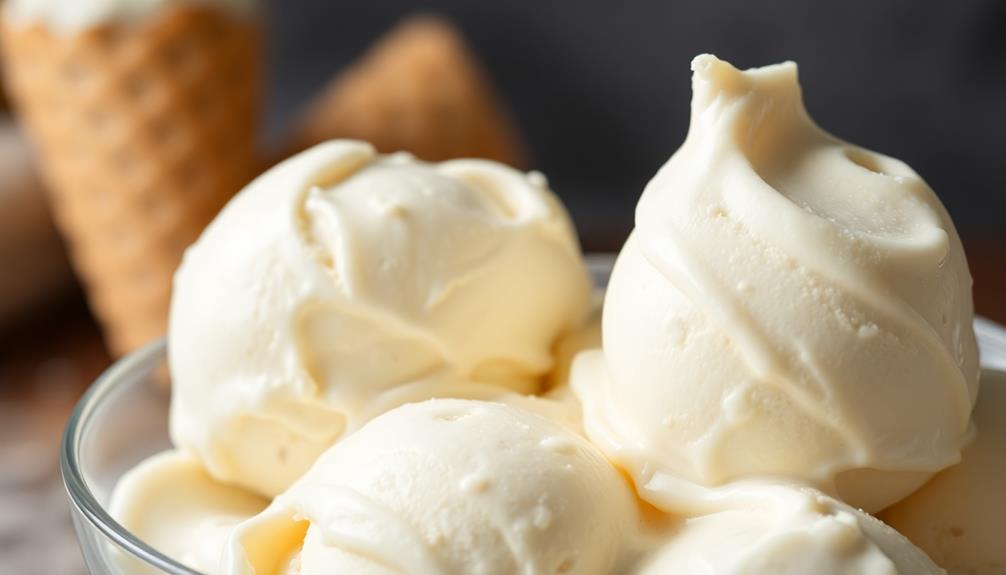
When it comes to ice cream, stabilizers play an essential role in enhancing its texture, making each scoop smoother and creamier.
They also help your favorite treat resist melting, so you can enjoy it longer without a mess.
Plus, by controlling ice crystal growth, stabilizers guarantee every bite is consistently delightful.
Texture Improvement
Stabilizers play an indispensable role in enhancing the texture of ice cream, transforming it from a simple frozen treat into a luxurious dessert experience. By effectively reducing ice crystal growth, stabilizers create a smoother and creamier mouthfeel that greatly improves consumer satisfaction.
Here's how stabilizers contribute to texture improvement:
- Smaller Ice Crystals: They maintain ice crystals at 10-20 µm, crucial for achieving the desired texture.
- Increased Viscosity: Stabilizers enhance the overall viscosity of the ice cream mix, which aids in trapping air and fat, leading to a creamier body.
- Uniformity: They guarantee a consistent texture throughout the product's shelf life, preventing coarse or grainy textures caused by temperature fluctuations.
- Reduced Melting Rates: By slowing down melting rates, stabilizers help ice cream retain its shape longer, enhancing the overall eating experience.
Incorporating stabilizers not only improves mouthfeel but also guarantees that every scoop delivers a consistent, enjoyable texture.
With these benefits, it's clear why stabilizers are crucial for premium ice cream production.
Melting Resistance
The smooth texture you enjoy in ice cream is just the beginning; melting resistance is another vital benefit of stabilizers that enhances the overall experience. Stabilizers increase viscosity, which slows down the melting rate and helps maintain the product's shape during serving. This means you can savor your ice cream longer without it turning into a puddle.
With stabilizers in the mix, you'll notice a more uniform distribution of air bubbles and fat, contributing to a slower meltdown and an improved texture. Ice creams containing stabilizers exhibit considerably better shape retention, preventing foam collapse and maintaining aesthetic appeal for consumers. This not only keeps your ice cream looking great but also guarantees it tastes delightful.
Moreover, effective use of stabilizers extends the shelf life of ice cream by preventing ice recrystallization, which can lead to an icy and unpleasant eating experience. Research shows that higher viscosity ice creams, achieved through stabilizers, receive better creaminess ratings, ultimately enhancing consumer satisfaction.
Ice Crystal Control
A significant benefit of using stabilizers in ice cream production is their ability to control ice crystal formation. By incorporating ingredients like guar gum, you help create a smoother texture and enhance the creaminess of your ice cream.
Here's how stabilizers make a difference:
- Smaller Ice Crystals: Stabilizers maintain ice crystal sizes between 10-20 µm, resulting in a velvety mouthfeel.
- Increased Viscosity: They boost the viscosity of the ice cream mix, reducing ice crystal movement during freezing and preventing a grainy texture.
- Reduced Recrystallization: Stabilizers limit ice recrystallization due to temperature fluctuations, which enhances the overall quality of the product.
- Cryoprotection: They prevent ice crystal aggregation, ensuring the integrity of your frozen treat over time.
Best Practices for Use

When incorporating stabilizers into your ice cream mix, aim for a concentration between 0.1-0.5% of the total weight to achieve that perfect texture. This range helps you avoid compromising mouthfeel while effectively controlling ice crystal formation.
Proper hydration of stabilizers is vital; disperse them with dry ingredients and consider using heat to guarantee complete dissolution.
Don't shy away from experimentation with different stabilizer combinations. This can enhance texture and stability, helping you tackle specific formulation challenges.
It's also important to monitor the balance between stabilizers and emulsifiers. Too much of either can create undesirable textures, such as gumminess or chewiness.
Regular testing of your final product's texture and melting characteristics is recommended. This allows you to adjust stabilizer levels to meet your goals and achieve peak consumer satisfaction.
By adhering to these best practices, you'll improve your ice cream's overall quality, leading to a product that delights your customers.
Alternative Stabilizer Options
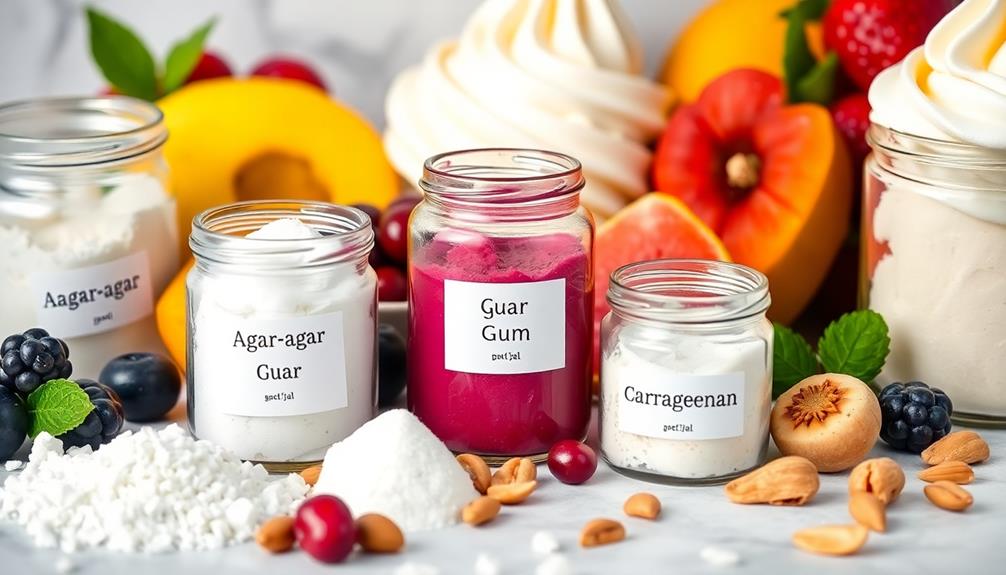
Exploring alternative stabilizer options can greatly enhance your ice cream formulations, offering unique textures and accommodating various dietary needs.
Using alternative stabilizers not only improves the texture and viscosity of your ice cream but also helps you cater to specific dietary restrictions. Here are some excellent choices:
- Tapioca Flour: A gluten-free option that enhances texture and viscosity.
- Flax Seed Gel: This plant-based stabilizer provides emulsifying properties, making it ideal for vegan ice cream.
- Agar: Derived from seaweed, it acts as a gelatin substitute, contributing to a smooth texture.
- Pectin: Found in fruits, it helps with moisture retention and prevents ice crystal growth.
Frequently Asked Questions
How Do Stabilizers Work in Ice Cream?
Stabilizers improve ice cream's texture by increasing viscosity, trapping air and fat. They reduce ice crystal growth, ensuring a smooth mouthfeel. Using the right amount is key, so avoid excess that causes gumminess.
Why Are Stabilizers Helpful in Ice Cream?
Imagine creamy, smooth ice cream melting slowly on your tongue. Stabilizers keep that delightful texture intact, preventing ice crystals from forming and ensuring every bite is rich and flavorful, enhancing your overall tasting experience.
What Is the Role of Stabilizer and Emulsifier in Ice Cream?
Stabilizers and emulsifiers work together to enhance your ice cream's texture and consistency. They prevent separation, improve creaminess, and guarantee a smooth mouthfeel, making every scoop enjoyable and satisfying without undesirable gumminess.
How Do Stabilizers Reduce Ice Crystal Size in Ice Cream?
Ever wondered how some ice cream stays delightfully smooth? Stabilizers work their magic by trapping water molecules, slowing ice crystal growth, and ensuring each scoop offers that creamy texture you crave without the icy crunch.
Conclusion
In the world of ice cream production, stabilizers are the unsung heroes, ensuring your favorite treat stays creamy and delightful. They work behind the scenes, preventing ice crystals from becoming pesky intruders. By using the right stabilizers, you're not just enhancing texture; you're elevating the whole ice cream experience. So, whether you're crafting a classic vanilla or an adventurous flavor, remember that stabilizers are the secret ingredient to a scoop that's always smooth and satisfying.
Beyond the realm of flavor and technique, Adriano recognizes the importance of sustainability and conscious consumption. His writing often explores eco-friendly practices within the ice cream industry, highlighting the use of locally sourced ingredients, reducing waste, and supporting ethical production methods.
Frozen Delights
What Ice Cream Is Good for Diabetics? Sweet and Safe Choices!
Looking for a sweet treat that won't spike your blood sugar? Discover the perfect ice cream options for diabetics that are both delicious and safe.

For a delicious and diabetes-friendly choice, consider Edys Slow Churned, Breyers Creamy Vanilla, Blue Bunny, or Halo Top. These brands provide low sugar, high protein ice creams that can assist in controlling your blood sugar levels. These options are specifically designed to meet your health requirements while still delivering great flavor.
Key Takeaways
- Choose ice creams with 20g of carbs or less per serving.
- Opt for low sugar varieties high in protein.
- Look for diabetic-friendly options like Halo Top.
- Consider brands like Edys, Breyers, and Blue Bunny.
- Monitor carb intake and stick to recommended serving sizes.
Criteria for Diabetic-Friendly Ice Cream
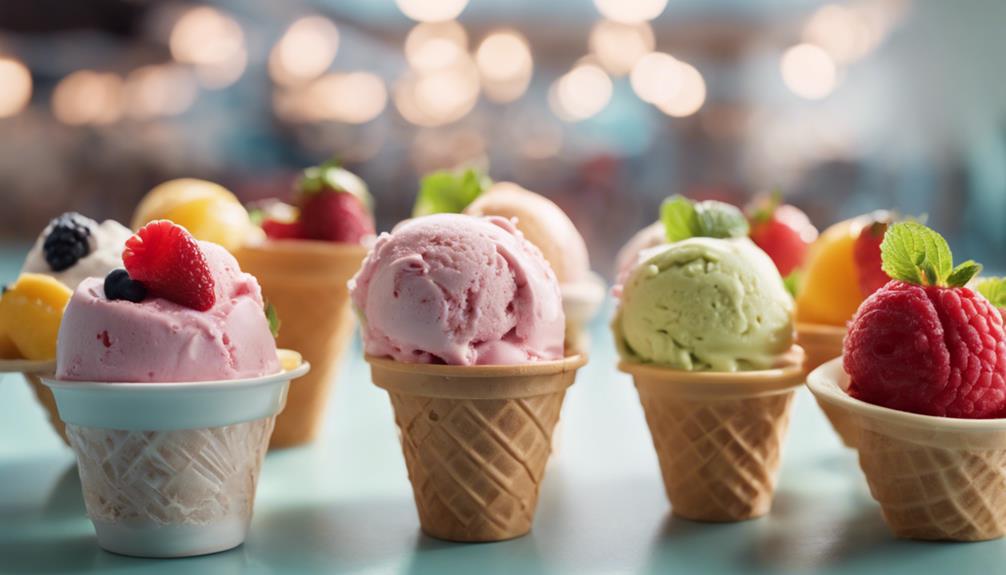
When choosing ice cream suitable for diabetes management, prioritize options with 20g of carbs or less per serving. Keeping an eye on sugar content is vital, so opt for low sugar varieties that also boast high protein to slow down sugar absorption.
Brands like Halo Top are excellent choices for diabetics, offering low sugar and high protein content along with the use of erythritol as a sweetener. Look out for ice cream brands such as Blue Bunny, Breyers, and Edys, known for their lower carb options that align well with diabetic dietary needs.
Remember to monitor your carb intake diligently and stick to recommended serving sizes to maintain stable blood sugar levels. Checking nutrition facts on ice cream labels can help you make informed choices that are both satisfying and safe for managing diabetes effectively.
Top Brands for Diabetics

For diabetics looking for suitable ice cream options, consider these top brands known for their diabetic-friendly choices. These brands offer lower sugar and carb content, making them great options for better blood sugar control in your diabetes meal: Some popular diabetic-friendly ice cream brands include Halo Top, Enlightened, and Arctic Zero. These brands have a history of creating delicious frozen treats with lower sugar and carb content, making them ideal for those with diabetes. While it’s important to still enjoy these treats in moderation, having these options available can make managing blood sugar levels a little easier for those with a sweet tooth and a history of ice cream enjoyment.
- Edys Slow Churned Ice Cream: Contains 20g of carbs or less per serving, a suitable choice for diabetics.
- Breyers Creamy Vanilla Ice Cream: With 17g of carbs per serving, it's a lower-carb option for those managing diabetes.
- Blue Bunny Ice Cream: Offers options with 20g of carbs per serving, aligning well with diabetic dietary guidelines.
- Halo Top Ice Cream: A diabetic-friendly choice with low sugar, high protein content, and sweetened with erythritol.
- Other Brands: Look for ice creams labeled as low sugar or diabetic-friendly for the best choices in managing your blood sugar levels while still enjoying a sweet treat.
Net Carbs in Ice Cream Pints
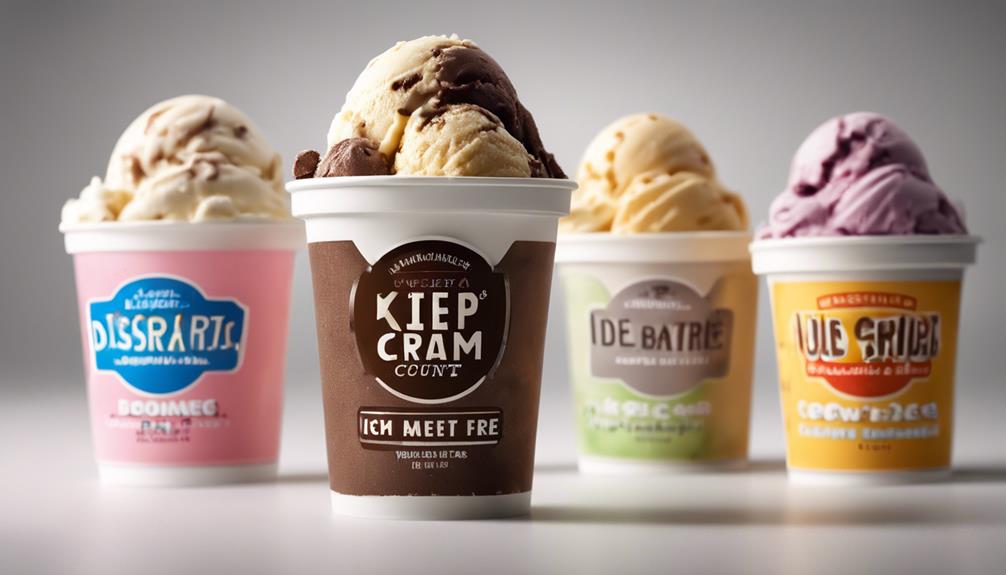
Let's compare the net carbs in different ice cream pints to make informed choices.
Analyze the caloric content to balance your dietary needs.
Consider the flavor and texture preferences to find the best option for your taste buds.
Net Carb Comparison
Among ice cream pints, Mammoth Creameries Keto Chocolate stands out with the lowest net carbs at 2g per serving.
If you're looking for diabetic-friendly options, consider these net carb comparisons:
- Enlightened Brownies & Cookie Dough and Rebel Ice Cream Cookie Dough also offer 2g net carbs per serving.
- Keto Pint Ice Cream provides 3g net carbs in pints and 2g in bars, with around 200 calories per serving.
- Simple Truth Keto French Ice Cream Black Raspberry Chip contains 3g net carbs and 190 calories per serving.
- So Delicious Dairy-Free Butter Pecan has 3g net carbs and 210 calories per serving, but only scores 2 stars for review.
These options vary in net carbs and calories, offering a range of choices for those seeking low-carb ice cream pints that are suitable for diabetes management.
Choose wisely based on your preferences and dietary requirements.
Caloric Content Analysis
To explore the caloric content and net carb distribution in various ice cream pints suitable for diabetics, consider the following analysis. When looking at diabetic-friendly ice cream options, it's essential to pay attention to both the caloric content and net carbs to manage blood sugar levels effectively. Here is a breakdown of some low-calorie and keto ice cream pints sweetened with monk fruit and erythritol:
| Ice Cream Brand | Serving Size | Caloric Content | Net Carbs | Taste Rating |
|---|---|---|---|---|
| Mammoth Creameries Keto Chocolate | 1 serving | 250 calories | 2g | – |
| Enlightened Brownies & Cookie Dough | 1 serving | 100 calories | 2g | 4 stars |
| Rebel Ice Cream Cookie Dough | 1 serving | 210 calories | 2g | 3.5 stars |
| Simple Truth Keto French Ice Cream Black Raspberry Chip | 1 serving | 190 calories | 3g | 4 stars |
These options provide a delicious treat while keeping your dietary needs in check. Make sure to enjoy them in moderation to maintain a balanced diet.
Flavor and Texture
The flavor and texture of low-carb ice cream pints can vary greatly based on their net carb content. When looking for a tasty option that won't spike your blood sugar, consider the following factors:
- Mammoth Creameries Keto Chocolate: With only 2g of net carbs per serving, this low-carb option offers a rich chocolate flavor without artificial sweeteners.
- Enlightened Brownies & Cookie Dough: Combining indulgent brownie and cookie dough flavors with 2g of net carbs, this ice cream has earned a solid 4-star review for its taste and consistency.
- Rebel Ice Cream Cookie Dough: Providing a delicious treat with 2g of net carbs, this option offers sweetness without artificial sweeteners and has a respectable 3.5-star review score.
- Keto Pint Ice Cream: Available in pints and bars with 3g and 2g of net carbs respectively, this brand has a 4-star review and uses natural sweeteners for a guilt-free dessert.
- Simple Truth Keto French Ice Cream Black Raspberry Chip: With 3g of net carbs and a 4-star review, this ice cream is praised for its balanced sweetness and delightful consistency.
Mammoth Creameries Keto Chocolate Review

Having only 2g of net carbs per serving, Mammoth Creameries Keto Chocolate ice cream offers a low-carb option for diabetics. This high-fat ice cream is sweetened with xylitol, making it a safe choice for those looking to manage their blood sugar levels.
Despite its low carb content, Mammoth Creameries Keto Chocolate provides 250 calories per serving. Reviewers have given this ice cream 2.5 stars, noting its crumbly texture and rich flavor.
The use of xylitol in this ice cream minimizes its initial impact on blood sugar levels, which can be beneficial for individuals with diabetes. If you're seeking a dessert that aligns with a low-carb diet and won't cause significant spikes in blood sugar, Mammoth Creameries Keto Chocolate could be a suitable option to satisfy your sweet cravings without straying from your dietary goals.
Enlightened Brownies & Cookie Dough Ice Cream
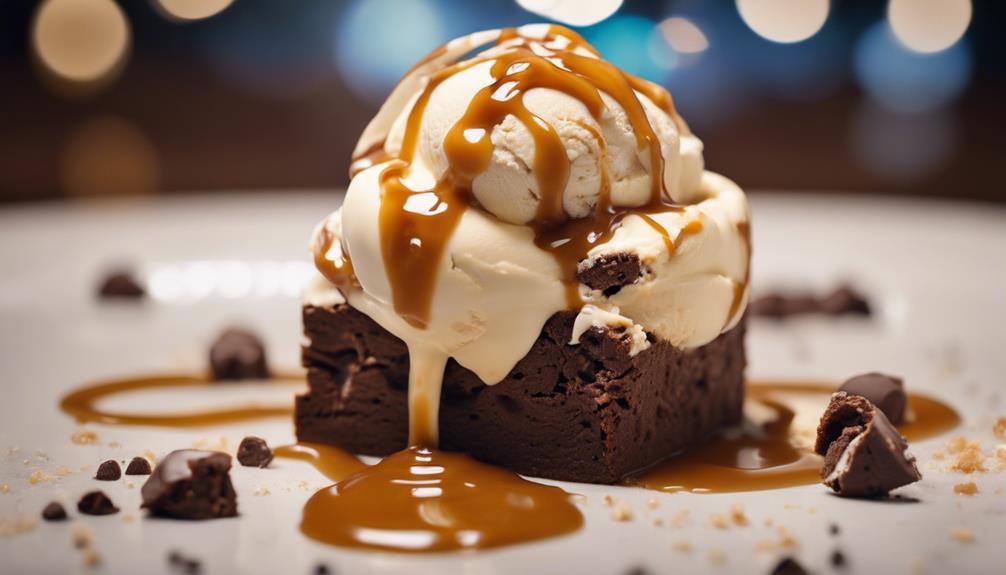
You'll love the flavorful blend of Enlightened Brownies & Cookie Dough Ice Cream, a perfect low-carb dessert option for those watching their sugar intake.
Sweetened with erythritol, this ice cream won't cause significant spikes in your blood sugar levels.
Indulge guilt-free with this delicious treat that combines white chocolate with cookie dough, brownie, and chocolate chunks.
Flavorful Ice Cream Blend
Wondering how you can enjoy a delicious ice cream treat without worrying about your blood sugar levels? Enlightened Brownies & Cookie Dough Ice Cream might just be the answer. This low-carb ice cream option isn't only flavorful but also safe for diabetics.
Here's why it's a great choice:
- Only 2g of net carbs per serving: Perfect for those looking to manage their carb intake.
- Low in calories, with just 100 calories per serving: Enjoy a guilt-free indulgence.
- Sweetened with erythritol: Minimizes the impact on blood sugar levels.
- Features a white chocolate base: A luxurious and creamy texture that complements the mix-ins.
- Blend of cookie dough, brownie, and chocolate chunks: A delightful combination that satisfies your sweet cravings.
With Enlightened Brownies & Cookie Dough Ice Cream, you can treat yourself to a delectable dessert while keeping your health in check.
Low-Carb Dessert Option
Indulge in Enlightened Brownies & Cookie Dough Ice Cream, a delectable low-carb dessert option perfect for diabetics. This diabetic-friendly ice cream boasts a mere 2g of net carbs per serving, making it an excellent choice for those mindful of their blood sugar levels. The white chocolate base of this treat is generously loaded with cookie dough, brownie pieces, and chocolate chunks, satisfying your sweet cravings without any hesitation.
To highlight the nutritional value of Enlightened Brownies & Cookie Dough Ice Cream, take a look at the table below:
| Nutritional Information | Per Serving (2/3 cup) |
|---|---|
| Calories | 90 |
| Total Fat | 4.5g |
| Net Carbs | 2g |
| Sugar | 1g |
| Protein | 6g |
Sweetened with erythritol, this low-carb delight guarantees a minor impact on blood sugar levels while still providing a delightful dessert option. So, go ahead and treat yourself to a scoop of Enlightened Brownies & Cookie Dough Ice Cream for a guilt-free indulgence!
Sweetened With Erythritol
Sweetened with erythritol, Enlightened Brownies & Cookie Dough Ice Cream offers a delicious and low-carb dessert option for individuals managing their blood sugar levels. This diabetic-friendly ice cream utilizes erythritol, a sugar alcohol that has minimal impact on blood sugar levels, making it a suitable choice for diabetes management.
With only 2g of net carbs per serving, it allows diabetics to enjoy a sweet treat while keeping their carbohydrate intake in check. The ice cream features a delightful combination of a white chocolate base, generous amounts of cookie dough, brownie, and chocolate chunks, garnering a solid 4-star review score.
Best Ice Creams for Type 2 Diabetes
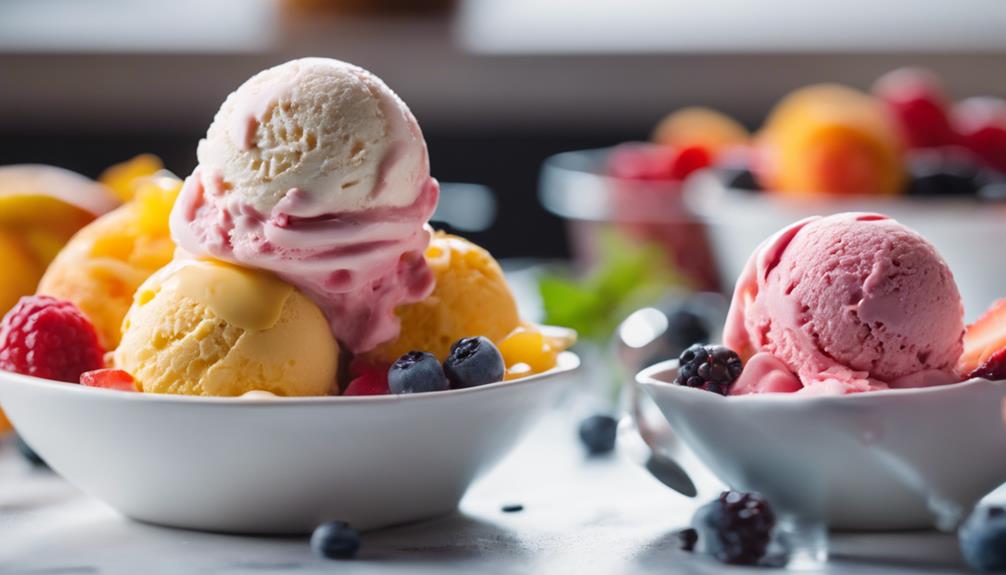
For individuals managing type 2 diabetes, selecting ice creams with lower sugar and carbohydrate content is essential for maintaining blood sugar levels within a healthy range.
When looking for the best ice creams for diabetics, consider options like Edys Slow Churned Ice Cream, which contains 20g of carbs or less per serving, providing a suitable choice for those with diabetes.
Breyers Creamy Vanilla ice cream is another excellent option with only 17g of carbs per serving, offering a lower carbohydrate alternative for diabetic individuals.
Blue Bunny Ice Cream also offers varieties with 20g of carbs per serving, making it a diabetic-friendly choice for those watching their carbohydrate intake.
Additionally, Halo Top ice cream is low in sugar, high in protein, and sweetened with erythritol, making it a safe and delicious choice for people managing type 2 diabetes.
Frequently Asked Questions
What Kind of Ice Cream Can a Diabetic Person Eat?
You can enjoy ice cream as a diabetic by choosing options with low sugar and carb content. Look for brands like Edys Slow Churned, Breyers Creamy Vanilla, Blue Bunny, or Halo Top, ensuring each serving contains 20g of carbs or less. In addition to choosing low sugar and carb options, you can also consider making your own ice cream at home using sugar substitutes like stevia or monk fruit. Another option is to try alternative dairy products like coconut milk or almond milk to create a delicious and diabetic-friendly frozen treat. The history of ice cream dates back to ancient civilizations who would mix snow or ice with fruit and honey, and it has since evolved into the beloved dessert we enjoy today. When it comes to enjoying ice cream and diabetes, moderation is key. It’s important to pay attention to portion sizes and how ice cream fits into your overall meal plan. With the right choices and consideration, people with diabetes can still savor a scoop of their favorite frozen treat without negatively impacting their blood sugar levels. By being mindful of ingredients and portion sizes, people with diabetes can still indulge in the occasional ice cream treat while managing their condition effectively.
Can Diabetics Eat Blue Bell No Sugar Added Ice Cream?
Yes, diabetics can enjoy Blue Bell No Sugar Added Ice Cream. It's a delicious option sweetened with substitutes like maltitol and Splenda. With around 15g of carbs per serving, it's a safe choice for managing blood sugar levels.
What Is a Healthy Sweet for a Diabetic?
For a diabetic, a healthy sweet option can be low-sugar or sugar-free ice cream like Breyers Creamy Vanilla, Blue Bunny, Edys Slow Churned, or Halo Top. Enjoy these choices in moderation to manage blood sugar levels effectively.
What Ice Cream Has the Least Sugar in It?
When looking for ice cream with the least sugar, opt for brands like Halo Top, Edys, Breyers, or Blue Bunny. These choices offer diabetic-friendly options with lower sugar content, making them a sweet treat you can enjoy guilt-free.
Conclusion
So, next time you're craving something sweet and safe for your diabetes, remember to reach for that pint of ice cream!
Who knew that indulging in a delicious treat could actually be good for your health?
With options like Mammoth Creameries Keto Chocolate and Enlightened Brownies & Cookie Dough, you can satisfy your cravings without worrying about blood sugar spikes.
Treat yourself to a guilt-free dessert and enjoy every spoonful!
As the Editor-in-Chief, Sara ensures that every piece of content published on the website is informative, engaging, and easy to follow. She believes in empowering readers to explore their creativity and experiment with various flavors and toppings. Sara’s step-by-step guides and clear instructions enable ice cream enthusiasts to create their own customized masterpieces that will impress friends and family.
With a wealth of experience in the culinary world, Sara brings a creative touch to Dri Dri Gelato’s content. She understands that ice cream is more than just a dessert—it’s a delightful experience that can bring joy and excitement to any occasion. Sara’s expertise lies in not only creating delicious ice cream recipes but also in teaching others the art of making ice cream at home, from the basics to the more advanced techniques.
-

 Frozen Delights1 week ago
Frozen Delights1 week agoBeginner’s Guide to Ice Cream Making: Tips and Tricks on Page 9!
-

 Vetted5 days ago
Vetted5 days ago15 Best Ice Cream Makers Under $200 to Satisfy Your Sweet Tooth
-

 Frozen Delights1 week ago
Frozen Delights1 week agoIce Cream and Diarrhea: Understanding the Link and How to Avoid It!
-

 Frozen Delights1 week ago
Frozen Delights1 week agoAnderson's Ice Cream: The Sweet Secret to Unforgettable Flavors!
-

 Frozen Delights1 week ago
Frozen Delights1 week agoThe Difference Between Ice Cream and Popsicles: Explained!
-

 Ice Cream Recipes1 week ago
Ice Cream Recipes1 week agoCreamy Perfection: Best Homemade Vanilla Ice Cream Recipes for Ice Cream Makers!
-

 Frozen Delights1 week ago
Frozen Delights1 week agoSonic the Hedgehog Ice Cream: A Nostalgic Treat for Fans!
-

 Frozen Delights5 days ago
Frozen Delights5 days agoCommon Ice Cream Questions: All You Need to Know About Your Favorite Treat!























